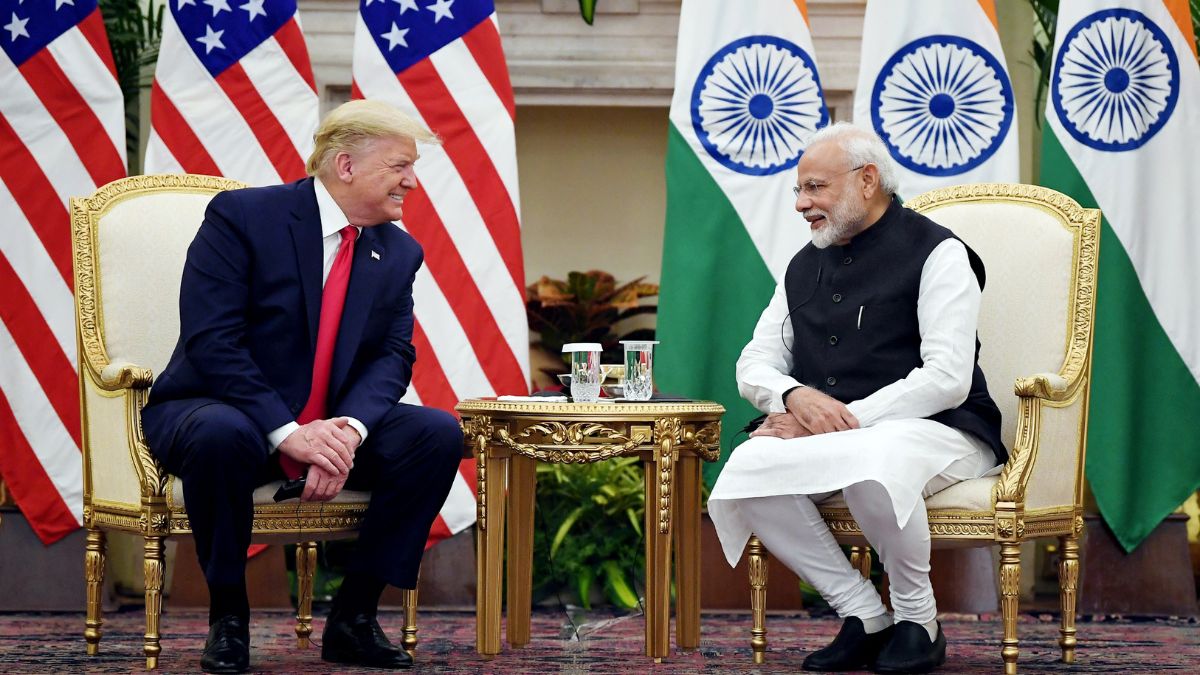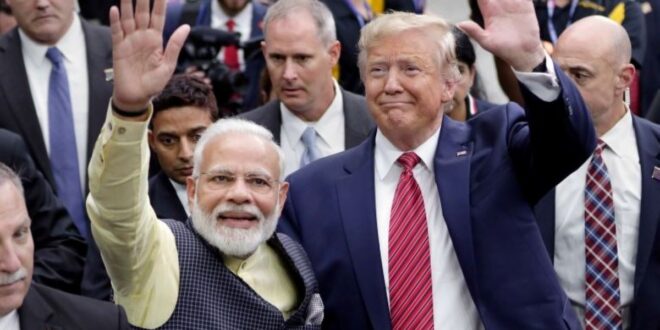Trump 2.0 and India-US Relations: Impact on Immigration, Trade, and Military : With the 2024 US elections approaching, India is closely monitoring the potential impacts of a Trump 2.0 presidency. For India, a major strategic partner for the US, Donald Trump’s return to the White House could bring both opportunities and challenges across various dimensions such as trade, immigration, military cooperation, and diplomacy. While Trump has often praised his relationship with Indian Prime Minister Narendra Modi, his “America First” policy may still influence these areas significantly. Here’s a deeper look into how a second Trump term could shape India-US relations.
1. Trade Relations: Boosts and Barriers
One of the areas where a Trump administration would likely have a notable impact is trade. In his previous term, Trump’s trade policies were marked by a focus on “reciprocity,” demanding that other countries provide the same market access and tariff rates to the US as the US offers them. Trump criticized countries that he felt imposed unfair tariffs on American products, including India. He once remarked, “India is a very big charger” when it comes to tariffs and hinted at his intention to introduce a “reciprocal tax” on Indian goods.
If Trump reinstates such policies, sectors crucial to the Indian economy—such as IT, pharmaceuticals, and textiles—could face greater challenges entering the US market. India, as a large exporter of generic drugs, software services, and textiles, benefits significantly from access to American consumers. A high tariff or reciprocal tax could restrict these sectors, impacting India’s exports to the US and possibly increasing costs for American consumers who rely on affordable Indian products. However, Trump’s approach to decoupling from China may offer India an advantage as it seeks to position itself as a manufacturing hub for US firms looking to reduce reliance on Chinese supply chains.
Under Trump 2.0, trade negotiations could be a tug-of-war between higher tariffs and improved market access in specific industries. However, Trump’s affinity for Modi and his general support for deepening US-India ties may temper the impact of new tariffs, with potential compromises that could benefit both economies.
2. Immigration: Challenges for Indian Professionals
Immigration policy has always been a contentious area, and Trump’s stance on immigration during his first term led to several restrictions on the H-1B visa program, which allows skilled foreign workers, primarily from India, to work in the US. Many Indian professionals in fields like technology, engineering, and healthcare depend on H-1B visas to contribute to the US economy. However, Trump’s earlier policies sought to prioritize American workers by increasing wage requirements for H-1B visa holders and introducing more stringent eligibility criteria.
Should Trump reintroduce such measures, it could create challenges for Indian professionals, particularly those in the tech industry, and could affect Indian IT firms that operate in the US and rely on a strong pool of skilled Indian employees. India’s talent pipeline, which has greatly contributed to the US tech sector, could face constraints, impacting the innovation and growth of companies dependent on these skilled workers. Furthermore, Indian students aspiring to work in the US after completing their studies may find fewer opportunities under a Trump administration, potentially affecting future brain drain to the US.
However, there may be scope for negotiation between the US and India, as the contributions of Indian professionals are widely recognized. Additionally, Trump’s rapport with Modi may encourage the former president to seek a balanced approach that continues to attract top talent while addressing American workers’ concerns.
3. Military and Defence Cooperation
India-US defence collaboration has grown significantly, driven by a shared strategic interest in countering China’s influence in the Indo-Pacific region. Under the Biden administration, the Initiative on Critical and Emerging Technology (iCET) and key defence deals, such as the GE-HAL agreement for manufacturing jet engines in India, underscored the strengthening of this relationship. A Trump 2.0 presidency might bring a slightly different approach but would likely continue to support India’s defence capabilities given China’s growing assertiveness.
Trump 2.0 and India-US Relations: Impact on Immigration, Trade, and Military

Trump’s views on military alliances are often cautious and emphasize cost-sharing. His critiques of NATO, for instance, reflect his stance that the US should not disproportionately shoulder the burden of global defence responsibilities. While India is not part of a traditional alliance structure with the US, the two countries’ alignment on defence could allow their military partnership to deepen. The Quad alliance, which includes the US, India, Japan, and Australia, could be another focal point under Trump’s leadership, as it aligns with his stance on containing China without binding the US to formal security commitments.
Increased defence cooperation could manifest through further arms sales, technology transfers, and joint exercises. Trump may continue arms sales to India, building on previous deals and fostering India’s self-reliance in defence production. This could benefit India’s domestic military industries, aligning with India’s “Atmanirbhar Bharat” (self-reliant India) initiative. India’s reliance on the US for military technology could also enhance interoperability between their armed forces, further strengthening deterrence against regional adversaries.
4. Diplomatic Dynamics and Shared Security Concerns
Diplomatically, India and the US share mutual concerns about regional stability, particularly regarding Pakistan and counterterrorism. Trump’s “Peace through Strength” policy could align well with India’s security interests, as he has been a vocal critic of countries perceived to be soft on terrorism. India has long sought stronger US support for holding Pakistan accountable for terrorist activities along the Indo-Pak border. Under Trump’s watch, US rhetoric on Pakistan grew stronger, and a second term could see even firmer stances, supporting India’s counterterrorism efforts.
However, Trump’s “America First” policy could impact US engagement in global diplomacy, potentially resulting in a more isolationist approach. India may face the challenge of navigating this shift in areas like climate change, where Trump’s stance diverges significantly from India’s commitments to sustainable development. Nonetheless, India’s significance as a regional stabilizer could ensure its continued strategic importance to the US, even under an “America First” framework.
5. The Modi-Trump Camaraderie: A Diplomatic Asset
The personal camaraderie between Trump and Modi, showcased in high-profile events like “Howdy, Modi!” and “Namaste Trump,” adds a unique diplomatic layer to India-US relations. The two leaders have publicly expressed admiration for one another, and Trump has acknowledged Modi’s influence in bringing India together as a powerful nation. This rapport could play a pivotal role in shaping policy discussions on trade, immigration, and defence.
Trump’s respect for Modi and India’s growing global influence could motivate him to maintain robust relations, despite policy differences. Modi’s close relationship with Trump may provide India leverage, particularly in areas where mutual respect and understanding can facilitate policy accommodations.
Trump 2.0 and India-US Relations: Impact on Immigration, Trade, and Military
In Conclusion
A second Trump term would likely bring both challenges and opportunities for India-US relations, characterized by nuanced negotiations. Trade tensions could rise, yet India may gain an edge as the US seeks alternatives to China for manufacturing. Immigration restrictions could pose hurdles, but the Modi-Trump camaraderie may allow for tailored policies that benefit both economies. On the defence front, military cooperation would likely deepen, with a shared goal of countering China’s influence.
For India, navigating a Trump 2.0 presidency will require adept diplomacy and strategic foresight. India’s focus on strengthening its domestic industries and maintaining a strong partnership with the US could help it capitalize on the potential benefits of Trump’s policies while mitigating their challenges.
 Social Hungama Hindi News, हिंदी न्यूज़ , Hindi Samachar, हिंदी समाचार, Latest News in Hindi, Sarkari Result
Social Hungama Hindi News, हिंदी न्यूज़ , Hindi Samachar, हिंदी समाचार, Latest News in Hindi, Sarkari Result




